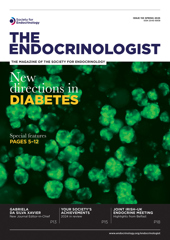Continuous glucose monitoring (CGM) has transformed the landscape of diabetes care, providing patients and clinicians with unprecedented insights into glucose dynamics. From its early days as a supplementary monitoring tool, CGM has evolved into a cornerstone of advanced diabetes management, particularly with its integration into hybrid closed-loop (HCL) systems. This evolution, coupled with new NICE guidelines on adoption of HCL systems,1 signals a paradigm shift in the treatment of type 1 diabetes, paving the way for a more automated and personalised approach.

Diabetes technology has transformed diabetes care. Credit: Shutterstock
TRANSFORMING DIABETES MANAGEMENT WITH CGM
CGM technology continuously measures interstitial glucose levels, providing real-time feedback on trends and variability. Data from the Association of British Clinical Diabetologists audit show that patients using CGM experience improved glycaemic outcomes, reduced episodes of hypoglycaemia, and better quality of life.2 This innovation has shifted the focus from static glycaemic control metrics, such as glycated haemoglobin (HbA1c), to dynamic measures, such as time-in-range3 and time-below-range4 glycaemic variability, which better reflect daily glucose patterns. Furthermore, CGM data empower clinicians to personalise interventions by identifying patterns that traditional methods of self-monitoring of blood glucose often miss.
HYBRID CLOSED-LOOP SYSTEMS: THE NEXT FRONTIER
The real-world data from the NHS England closed-loop pilot5 have shown us that HCL systems are associated with improvements in HbA1c, time-in-range, hypoglycaemia, diabetes-related distress and quality of life in people with type 1 diabetes. The NICE Technology Appraisal Guidance TA9431 (published 19 December 2023) recommends the use of HCL systems for managing blood glucose levels in adults, children and young people with type 1 diabetes.
'clinicians must navigate the learning curve associated with these advanced systems.'
These systems are suitable for individuals with an HbA1c of 58mmol/mol (7.5%) or higher, or those experiencing disabling hypoglycaemia despite optimal management using continuous subcutaneous insulin infusion or CGM. HCL systems are also recommended for pregnant individuals or those planning pregnancy. However, their use is contingent on being procured at a cost-effective price, as agreed by NHS England, and must follow the NHS implementation plan. The systems should be used with the support of a trained multidisciplinary team and only by individuals or carers capable of using them, with access to structured education programmes.
CHALLENGES AND FUTURE DIRECTIONS
Despite their benefits, CGM and HCL systems face barriers to widespread adoption. Cost remains a significant limitation, particularly in resource-limited settings. While initiatives such as the NHS provide subsidised access, global efforts are needed to ensure equitable availability. Education is another critical factor. For many patients, the wealth of data generated by CGM can be overwhelming. Structured education programmes are essential to help users interpret and act on CGM data effectively, maximising its potential. Finally, clinicians must navigate the learning curve associated with these advanced systems. Integrating CGM and HCL systems into practice requires familiarity with the technology and its implications for patient care.
CONCLUSION
CGM, particularly when integrated into HCL systems, has revolutionised diabetes care, marking a transformative shift comparable with the discovery of insulin. The recent NICE guidelines signify a critical milestone, providing a robust framework for the widespread adoption of HCL systems.
However, as we advance this new standard of care, it is imperative to address challenges related to accessibility, ensuring these ground-breaking technologies are available to all individuals, regardless of socioeconomic status or geographical location. By fostering innovation, promoting education, and championing equitable access, we can unlock the full potential of CGM and HCL systems, significantly enhancing quality of life for people living with diabetes.
HARSHAL DESHMUKH
Staff Specialist Endocrinologist, Mackay Base Hospital, Mackay, and Associate Professor, James Cook University, Townsville, Queensland, Australia; Honorary Consultant Endocrinologist, Hull University Teaching Hospital NHS Trust
REFERENCES
1. NICE 2020 https://www.nice.org.uk/guidance/ta943.
2. Deshmukh H et al. 2020 Diabetes Care https://doi.org/10.2337/dc20-0738.
3. Deshmukh H et al. 2022 Diabetic Medicine https://doi.org/10.1111/dme.14942.
4. Deshmukh H et al. 2025 Diabetes Care https://doi.org/10.2337/dc24-1833.
5. Crabtree TSJ et al. 2023 Diabetes Care https://doi.org/10.2337/dc23-0635.






